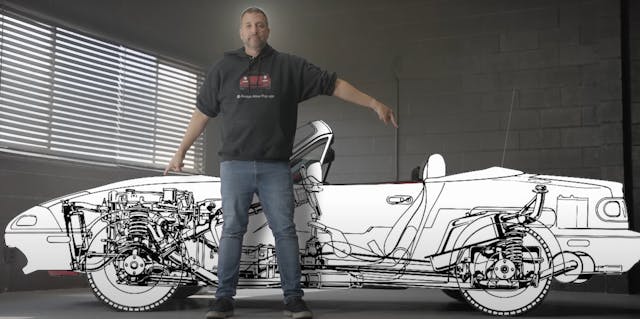The Mazda Miata Had No Chance of Success | Revelations—Ep. 33
This is the unlikely success story of the Mazda MX-5 Miata—the world’s bestselling two-seat roadster and the only remaining true lightweight sports car. Mazda, of course, made its name in the 1970s with small rotary-powered runabouts and then the RX-7 sports car. Had the company listened to the experts, however, the Miata never would have happened. And if Mazda had listened to its own customers, it never would have succeeded.

Instead, the Mazda Miata has succeeded where every other lightweight sports car has failed, by decidedly not giving the customer what they want. No more weight, no extra complexity, no excessive speed, no ultra luxury.
On this episode of Revelations, Jason Cammisa welcomes special guest Tom Matano, the father of the Miata, to tell the story of how the simple Japanese roadster has survived economic downturns and done the impossible. In the process, it has proven every other carmaker wrong. Because it turns out that cars can indeed be light, simple, and fun, even while meeting modern emissions and safety regulations.

And yet, somehow it almost never happened. Battles between Mazda HQ in Japan and the company’s North American office, which conceived the Lotus Elan–like roadster, almost resulted in a front-wheel-drive, or even a mid-engined, car. All of which led the original team with Matano and Bob Hall to ask for the project to be killed off. To just forget the whole thing.
Thankfully, Mazda didn’t do that. And 35 years later, the Miata reigns King of Sports Cars, selling the same amount of cars in the U.S. every year as Porsche sells 911s—despite the 911’s incredibly broad product offering.
***
Check out the Hagerty Media homepage so you don’t miss a single story, or better yet, bookmark it. To get our best stories delivered right to your inbox, subscribe to our newsletters.



The three most important qualities of a sports car to ensure success in the marketplace are Price, Price and Price. Followed closely by Price and Price. I bought a first Gen Miata – and still have it – because it was simple, balanced, a blast to drive and because I COULD AFFORD IT.
This is not hard to understand.
The only reason I’ve never bought one (same as why I had to pass on a Boxster) was: it’s simply too small inside to drive comfortably. I\m 6’4″ and about 245 lbs. and love the Miata but would look ridiculously cramped and be totally uncomfortable driving one. I wish it were the same just 25% bigger.
They built a reliable sport car and made it to appeal to men and women.
They kept the cost viable.
The problem now is the last time they had to share the platform to justify it and now I expect the price will have to grow more as there is no more sharing.
As for best selling 2 seater the Corvette I think easily has that title right now.
The Miata has beaten the 5-10 year life span most 2 seat cars end up facing. Few last past that. Even more so the lower the cost the harder it is to keep them alive.
One key element to the Miata was also to limit sales per year. You want to keep people wanting as you are limited to the changes you can make due to price. They spent a lot of time on limited editions with wheels and paint packages that are cheap to do.
Mazda did it right but I am not sure another company could copy this. Most do not have the discipline or ability to do as Mazda has.
It will be interesting to see how much longer this car lives. It will only get tougher for them to keep it going at the lower end price.